The Talented Mr. Turing
If you are reading this from a computer, then you should thank the guy below.
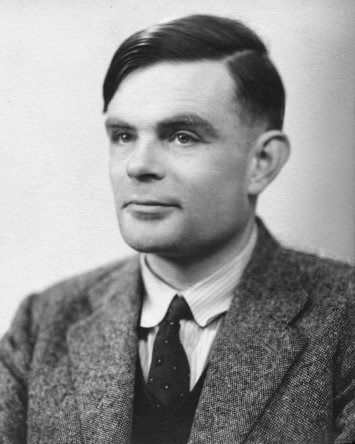
Despite these, when he admitted to being a practicing homosexual after the war, the British police had him punished for the “gross indecency”, a crime that is punishable either by imprisonment or chemical castration. Some historians believe his persecution to be one of the causes of his early death, a death that is to this day as laced in mystery as it is in cyanide.
It is indeed troubling that it was only less than a century ago that a law existed in Britain that criminalized homosexuality. What is more troubling is the fact that to this very day, similar laws persist in some parts of the world. Even in parts of the world where the law has moved past bigotry against homosexuality, there are still people who believe that Turing deserved his fate or that, at the very least, homosexuals like Turing do not deserve equal rights.
However, since it is Alan Turing’s 100th birthday, it would be more appropriate if we discuss things on a note of hope. After all, Turing himself lived his life with his head ever held high.
Alan Turing was among the most important thinkers of the twentieth century. His talent revealed itself from a very early age. However, his was not simply a genius (he was elected to a fellowship at King’s College at the age of 23) but also a powerful character. For example, on his first day of school at the Sherborne School in Dorset, he discovered that there was a general strike, which meant that all means of public transportation was cut off.
Although his house was more than 96 kilometers away from Dorset, this did not stop him, and he bicycled his way to school. He was only 14 years old then! It’s a small wonder that he grew up to be a world-class marathon runner, almost qualifying for the British Olympic team in 1948.
What set him apart from previous major thinkers was his way of attacking problems, which represented a fundamental shift in perspective. In this regard, Turing was the Galileo of the previous century.
Before Galileo, physics was grounded by the insistence that the workings of the natural world can be divined purely by rational thought; most of pre-Galilean physics was armchair physics. Galileo showed us once and for all that the scientific method the two Bacons (Francis and Roger before him) talked about was a creative mix of logical reasoning and careful experimentation and/or observation.
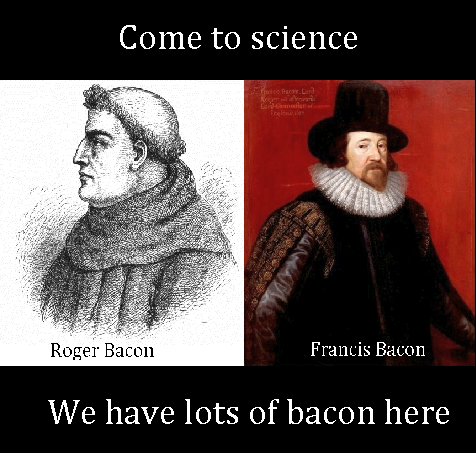
One of Turing’s lasting contributions to scientific thought, to me, was his restating in a very practical and testable way many problems that have been previously regarded only in the abstract. Let me give just two of the many possible examples to illustrate this point. First, we consider Turing machines and second, we consider the Turing test. (For those who are more interested in Turing’s life than in his contributions, you may skip the next two sections without loss of appreciation for the succeeding ones.)
Turing Machines
Let us start with a fellow named Bertrand Russell. Aside from sex, sets and classes were old Bertie’s lasting interests. A class is basically a collection of objects with similar properties. In one of his studies, old Bertie analyzed the properties of what he called the “set of all sets” and the “class of all classes”. This led him to the now famous Russell’s paradox. What is Russell’s paradox? Consider the class of all classes that do not belong to themselves. Does this class belong to itself? Mind effing, right?
Now, to avoid Russell’s paradox, some mathematicians and philosophers have resolved to be strict in their definition of sets and classes. They decided to call a collection of objects a set if and only if there is a clear-cut way of constructing it from scratch. This led them to restrict the number of rules one can use in arithmetic. And then along came Kurt Gödel who said that, roughly, such a restricted set of rules (what mathematicians and philosophers call a formal system) does not have the power to prove all true statements in arithmetic. He said this in his now famous Gödel’s incompleteness theorems. In other words, the incompleteness theorems imply that there are true statements in arithmetic that any formal system cannot prove.
All these are pretty abstract stuff. Enter Alan Turing and his Turing machines. Turing machines are abstract devices that can solve certain problems of arithmetic. Turing described the minimal requirements of his machine as follows: you have a very long (think infinitely long) strip of paper divided into cells, where each cell can contain a ‘0’ or a ‘1’, and a reader-writer that can read the content of each cell and print out a 0 or a 1 on an empty cell or replace the digit on a non-empty cell. However, since we have the benefit of computers, we can now think of Turing machines as simply idealized computer programs for solving specific problems.
Turing machines (think computer programs) are very important in mathematics and philosophy because they can be used to construct sets, which was the dream of philosophers and mathematicians. How? Think of the ‘0’ as a ‘no’ and the ‘1’ as a ‘yes’. If you want to construct the set of odd numbers starting from 0, 1, 2, 3, 4, and so on, a Turing machine will give you the output 01010101…, meaning “No, zero is not an odd number; yes one an odd number; no; yes; no; yes; …”
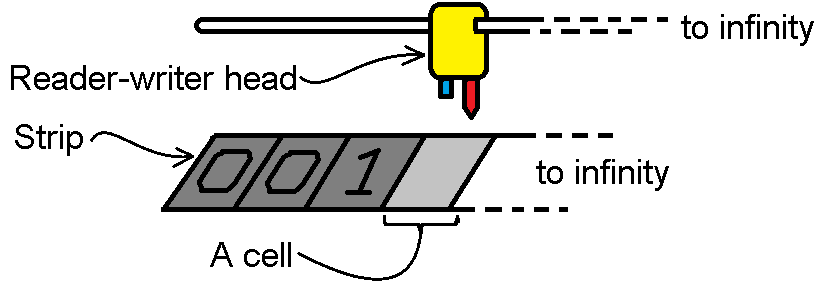
Now for Turing’s punch line: you cannot find a Turing machine that can determine whether another Turing machine can solve a problem in a finite period of time or not. The problem with some Turing machines, you see, is that it can take them an infinite amount of time to solve a problem – in short, they can’t solve it. But how do we know whether a Turing machine can solve a problem or not? Perhaps we can build another Turing machine to tell us “Yes, this Turing machine can solve it” or “No, this bloke of a machine cannot.”
Alan Turing showed the world that we cannot have such a machine. For the sharp reader, you could see that this is intimately related to what Gödel said. Only, instead of being stated in a very abstract way, Turing placed it on firmer ground by giving us the image of Turing machines.
The Turing Test
Another example of Alan’s powerful insight is his restating the problem of intelligence, particularly the problem of artificial intelligence, in terms of what is now known as the Turing test.
To put things into context, note that Turing was very intellectually promiscuous. (Yes, it can have two meanings, and in the case of Turing both meanings apply.) He did not really care what “field” a certain study was in. If he was interested in it, he studied it. And so while studying math and philosophy (although he never considered himself a philosopher), he also studied computer science and artificial intelligence. His papers on computability laid the foundations of modern computer science.
He was also acutely interested in the very philosophical problem of intelligence. Some of the questions he wrestled with were, “What is intelligence? Can we ever build a machine that can ‘think’? How can we build a brain? How do humans understand anything?” However, Turing found these questions too vague and ill-posed. To formulate them in a way that is amenable to scientific scrutiny, he devised the Turing test.
Here’s how the Turing test goes. Our cast of characters contains three individuals: Person A, Person X, and Machine Z. Place each of these characters in an isolated room so that they cannot “see” each other. Connect Person X and Machine Z to Person A via a network. (Think the internet; imagine they are chatting via Skype or, if you are old school, via MIRC.) Person A then asks certain questions to Person X and Machine Z via the network. Turing said that we can conclude that Machine Z has artificial intelligence if Person A cannot decide with certainty which of his interlocutors is man and which is machine.
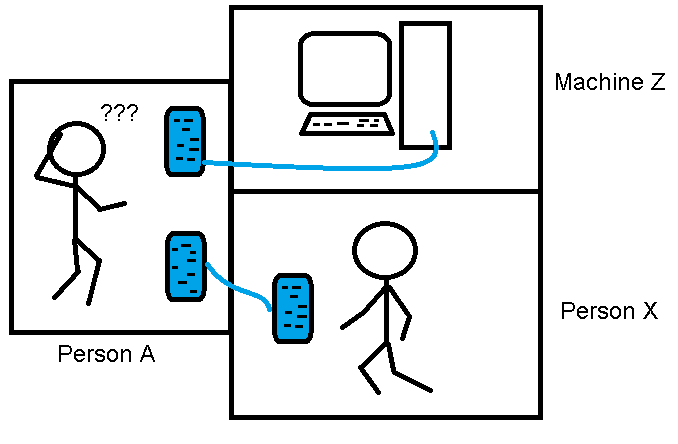
Philosophers, being people who have nothing better to do, are still arguing about the validity of the Turing test. But one can easily see that Turing’s take on the problem of artificial intelligence was a gargantuan improvement on previous attempts.
Turing’s Bombe
History will always remember Alan Turing as one of the critical figures in the British success in deciphering the Enigma code of the Nazis. During the Second World War, the Nazis used a machine called the Enigma machine to encipher the codes they used in wartime communication (such as communications between German U-boats). As one can easily see, figuring out what the Nazis were talking about is important in anticipating their next move and therefore beating them. During the war, Turing applied his genius to the problem of breaking the Nazi cipher. To do this, he invented and helped in constructing several deciphering machines; chief among these is what is now known as the Bombe.
![Bombe-1943 [computermuseum.li]](https://filipinofreethinkers.org/wp-content/uploads/2012/06/Bombe-1943-computermuseum.li_.jpg)
The Passion of Turing
If you think that for all his achievements, Turing would be celebrated as a pride of the British people, then you’re wrong. Some time after the war, a burglary forced Turing to admit to the police that he engaged in homosexual activities, which simply means that he was enjoying himself. Apparently, many forms of enjoying oneself were illegal in 1952 Britain. For being a sexually active gay guy, Turing was convicted of ‘gross indecency’. And indeed, under the law of the time, homosexual acts were illegal in Britain. (Such unjust laws persisted in many parts of the Western world well into the twentieth century.)
For his “crime”, the police asked Turing to choose between imprisonment and “chemical castration”. He chose the latter; this involved being injected with estrogens that were supposed to lower his libido.
However, instead of being dejected, Turing continued to be a strong-willed individual, diligently carrying on with his many researches for about two years up until his death in 1954. Police investigations revealed that Turing poisoned himself with cyanide. However, some, including Turing’s mother, claimed that he was accidentally poisoned due to his own carelessness with chemicals. (Chemistry was one of Turing’s many obsessions.) This claim was spurred by the fact that a bitten apple was found near the site of Turing’s death. The police, however, never tested the said apple for cyanide.
![apple_rainbow_logo [edibleapple.com]](https://filipinofreethinkers.org/wp-content/uploads/2012/06/apple_rainbow_logo-edibleapple.com_.jpeg)
Turing’s Lessons
Alan Turing’s rich and colorful life is something we should all learn from. I believe we should all try to embody his rarely-equaled passion for learning and his voracious appetite for understanding new things. His strong-willed reaction to his persecution for being gay should also be inspiration to those who continue to fight against laws and societies that attempt to repress and suppress diversity.
During the previous years, many people have urged the British government to issue a formal public apology for the treatment of Turing after the war. However, Lord McNally’s reaction to such calls seems, to me, to be most appropriate:
A posthumous pardon was not considered appropriate as Alan Turing was properly convicted of what at the time was a criminal offence. He would have known that his offence was against the law and that he would be prosecuted. It is tragic that Alan Turing was convicted of an offence which now seems both cruel and absurd—particularly poignant given his outstanding contribution to the war effort. However, the law at the time required a prosecution and, as such, long-standing policy has been to accept that such convictions took place and, rather than trying to alter the historical context and to put right what cannot be put right, ensure instead that we never again return to those times.
That means that Turing knew that his battle was against an unjust law, and he fought it by being who he was and by being proud of it. I therefore believe that the appropriate way to celebrate Turing’s centenary is to celebrate his achievements and his strength as well as the achievements of the LGBT community throughout the decades following Turing’s death. The mere fact that even some opponents of equal rights find Turing’s conviction unjust is already worth a little celebration.
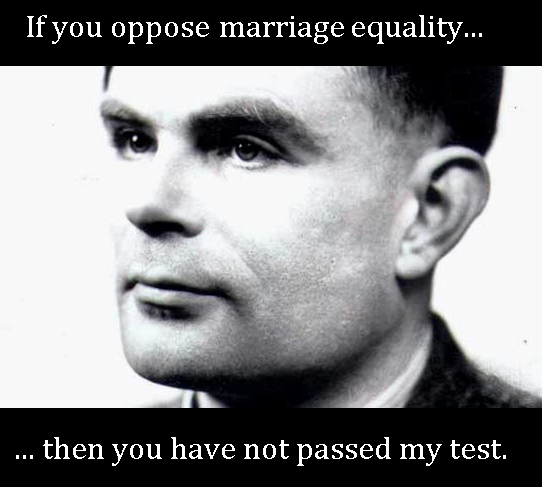
Here are a few of my humble suggestions on how to celebrate Turing’s 100th birthday:
- Eat an apple (just be sure it’s not laced with cyanide)
- Learn something totally new
- Learn more about computers
- Wear something colorful
- Share the story of Alan Turing to a friend who has not heard about him


We have a decades-old running argument about homo-eroticism that never gets settled with an approximation of the Turing Test. The thesis is that if you didn't know what gender it was that was giving you pleasure orally the intensity of your orgasm would be equal for both genders and proportionate only to the skill of the service provider, male or female (beasts not included because you'd know right away). But because none of us could find the courage to have the act performed on us by the wrong gender (an unthinkable abomination!) we'd never know until we die. And if we did consent we'd be too excited to participate in the test and might release the Kraken even without the bidding of Hades.